California
From Wikipedia, the free encyclopedia
For other uses, see California (disambiguation).
What is now California was first settled by various Native American tribes before being explored by a number of European expeditions throughout the 16th and 17th centuries. It was then claimed by the Spanish Empire as part of Alta California in the larger territory of New Spain. Alta California became a part of Mexico in 1821 following its successful war for independence, but would later be ceded to the United States in 1848 after the Mexican-American War. The western portion of Alta California was soon organized as the State of California, which was admitted as the 31st state on September 9, 1850. The California Gold Rush starting in 1848 led to dramatic social and demographic change, with large-scale immigration from the U.S. and abroad and an accompanying economic boom.
California's diverse geography ranges from the Pacific Coast in the west, to the Sierra Nevada in the east – from the Redwood–Douglas fir forests of the northwest, to the Mojave Desert areas in the southeast. The center of the state is dominated by the Central Valley, a major agricultural area. California contains both the highest and lowest points in the contiguous United States (Mount Whitney and Death Valley), and has the 3rd longest coastline of all states (after Alaska and Florida). Earthquakes are a common occurrence because of the state's location along the Pacific Ring of Fire: about 37,000 are recorded annually, but most are too small to feel.[14]
At least half of the fruit produced in the United States is now cultivated in California, and the state also leads in the production of vegetables.[15] Other important contributors to its economy include aerospace, education, manufacturing, and high-tech industry. If it were a country, it would be the 8th or 9th largest economy in the world[16] and the 34th most populous.
Contents
Etymology
Main article: Origin of the name California
The word California originally referred to the entire region composed of the Baja California peninsula of Mexico, the current U.S. states of California, Nevada, and Utah, and parts of Arizona, New Mexico, Texas and Wyoming.[citation needed]The name California is most commonly believed to have derived from a fictional paradise peopled by Black Amazons and ruled by Queen Calafia.[17][18] The story of Calafia is recorded in a 1510 work The Adventures of Esplandián, written as a sequel to Amadis de Gaula by Spanish adventure writer Garci Rodríguez de Montalvo.[19][20][21] The kingdom of Queen Calafia, according to Montalvo, was said to be a remote land inhabited by griffins and other strange beasts, and rich in gold.
Know ye that at the right hand of the Indies there is an island called California, very close to that part of the Terrestrial Paradise, which was inhabited by black women without a single man among them, and they lived in the manner of Amazons. They were robust of body with strong passionate hearts and great virtue. The island itself is one of the wildest in the world on account of the bold and craggy rocks.Shortened forms of the state's name include CA, Cal., Cali., Calif. and us-CA.
— Chapter CLVII of The Adventures of Esplandián[22]
Geography
Main article: Geography of California
A forest of redwood trees in Redwood National Park
Aerial view of the California Central Valley
A view of the Pacific coast in Big Sur
Snow on the Sierra Nevada in eastern California
Death Valley, in the desert regions of the Inland Empire
Potato Harbor on Santa Cruz Island
The coastline along Laguna Beach in Southern California
In the middle of the state lies the California Central Valley, bounded by the coastal mountain ranges in the west, the Sierra Nevada to the east, the Cascade Range in the north and the Tehachapi Mountains in the south. The Central Valley is California's agricultural heartland.
Divided in two by the Sacramento-San Joaquin River Delta, the northern portion, the Sacramento Valley serves as the watershed of the Sacramento River, while the southern portion, the San Joaquin Valley is the watershed for the San Joaquin River; both areas derive their names from the rivers that transit them. With dredging, the Sacramento and the San Joaquin Rivers have remained sufficiently deep that several inland cities are seaports.
The Sacramento-San Joaquin River Delta serves as a critical water supply hub for the state. Water is routed through an extensive network of canals and pumps out of the delta, that traverse nearly the length of the state, including the Central Valley Project and the State Water Project. Water from the Delta provides drinking water for nearly 23 million people, almost two-thirds of the state's population, and provides water to farmers on the west side of the San Joaquin Valley. The Channel Islands are located off the Southern coast.
The Sierra Nevada (Spanish for "snowy range") includes the highest peak in the contiguous 48 states, Mount Whitney, at 14,505 feet (4,421 m).[5][6][7] The range embraces Yosemite Valley, famous for its glacially carved domes, and Sequoia National Park, home to the giant sequoia trees, the largest living organisms on Earth, and the deep freshwater lake, Lake Tahoe, the largest lake in the state by volume.
To the east of the Sierra Nevada are Owens Valley and Mono Lake, an essential migratory bird habitat. In the western part of the state is Clear Lake, the largest freshwater lake by area entirely in California. Though Lake Tahoe is larger, it is divided by the California/Nevada border. The Sierra Nevada falls to Arctic temperatures in winter and has several dozen small glaciers, including Palisade Glacier, the southernmost glacier in the United States.
About 45 percent of the state's total surface area is covered by forests,[24] and California's diversity of pine species is unmatched by any other state. California contains more forestland than any other state except Alaska. Many of the trees in the California White Mountains are the oldest in the world; an individual Bristlecone pine has an age over 5,000 years.[25][26]
In the south is a large inland salt lake, the Salton Sea. The south-central desert is called the Mojave; to the northeast of the Mojave lies Death Valley, which contains the lowest and hottest place in North America, the Badwater Basin at −282 feet (−86 m).[9] The horizontal distance from the nadir of Death Valley to the summit of Mount Whitney is less than 90 miles (140 km). Indeed, almost all of southeastern California is arid, hot desert, with routine extreme high temperatures during the summer. The southeastern border of California with Arizona is entirely formed by the Colorado River, from which the southern part of the state gets about half of its water.
Along the California coast are several major metropolitan areas, including Greater Los Angeles Area, the San Francisco Bay Area, and the San Diego metropolitan area.
As part of the Ring of Fire, California is subject to tsunamis, floods, droughts, Santa Ana winds, wildfires, landslides on steep terrain, and has several volcanoes. It sees numerous earthquakes due to several faults, in particular the San Andreas Fault.
Climate
Main article: Climate of California
Much of the state has a Mediterranean climate, with cool, rainy winters and dry summers. The cool California Current offshore often creates summer fog
near the coast. Farther inland, one encounters colder winters and
hotter summers. The maritime moderation results in the shoreline
summertime temperatures of Los Angeles and San Francisco
being the coolest of all major metropolitan areas of the United States
and uniquely cool compared to areas on the same parallels in the
interior and on the east coast of the North American continent. Even the
San Diego
shoreline bordering Mexico is cooler in summer than most areas in
contiguous United States. Just a few miles inland, summer temperature
extremes are significantly higher, with downtown Los Angeles being
several degrees warmer than at the coast. The same microclimate phenomenon is seen in the climate of the Bay Area, where areas sheltered from the sea sees significantly hotter summers than nearby areas close to the ocean.Northern parts of the state average higher annual rainfall than the south. California's mountain ranges influence the climate as well: some of the rainiest parts of the state are west-facing mountain slopes. Northwestern California has a temperate climate, and the Central Valley has a Mediterranean climate but with greater temperature extremes than the coast. The high mountains, including the Sierra Nevada, have an alpine climate with snow in winter and mild to moderate heat in summer.
The east side of California's mountains produce a rain shadow, creating expansive deserts. The higher elevation deserts of eastern California see hot summers and cold winters, while the low deserts east of the Southern California mountains experience hot summers and nearly frostless mild winters. Death Valley, a desert with large expanses below sea level, is considered the hottest location in the world; the highest temperature in the world,[27][28] 134 °F (57 °C), was recorded there on July 10, 1913. The lowest temperature in California was −45 °F (−43 °C) in 1937 in Boca.
Ecology
Main article: Ecology of California
See also: Environment of California
California is one of the richest and most diverse parts of the world,
and includes some of the most endangered ecological communities.
California is part of the Nearctic ecozone and spans a number of terrestrial ecoregions.[29]California's large number of endemic species includes relict species, which have died out elsewhere, such as the Catalina Ironwood (Lyonothamnus floribundus). Many other endemics originated through differentiation or adaptive radiation, whereby multiple species develop from a common ancestor to take advantage of diverse ecological conditions such as the California lilac (Ceanothus). Many California endemics have become endangered, as urbanization, logging, overgrazing, and the introduction of exotic species have encroached on their habitat.
Flora and fauna
See also: Fauna of California
California boasts several superlatives in its collection of flora: the largest trees, the tallest trees, and the oldest trees. California's native grasses are perennial plants.[30] After European contact, these were generally replaced by invasive species of European annual grasses; and, in modern times, California's hills turn a characteristic golden-brown in summer.[31]Because California has the greatest diversity of climate and terrain, the state has six life zones which are the lower Sonoran (desert); upper Sonoran (foothill regions and some coastal lands), transition (coastal areas and moist northeastern counties); and the Canadian, Hudsonian, and Arctic Zones, comprising the state's highest elevations.[32]
Plant life in the dry climate of the lower Sonoran zone contains a diversity of native cactus, mesquite, and paloverde. The Joshua tree is found in the Mojave Desert. Flowering plants include the dwarf desert poppy and a variety of asters. Fremont cottonwood and valley oak thrive in the Central Valley. The upper Sonoran zone includes the chaparral belt, characterized by forests of small shrubs, stunted trees, and herbaceous plants. Nemophila, mint, Phacelia, Viola, and the California poppy (Eschscholzia californica) – the state flower – also flourish in this zone, along with the lupine, more species of which occur here than anywhere else in the world.[32]
The transition zone includes most of California's forests with the redwood (Sequoia sempervirens) and the "big tree" or giant sequoia (Sequoiadendron giganteum), among the oldest living things on earth (some are said to have lived at least 4,000 years). Tanbark oak, California laurel, sugar pine, madrona, broad-leaved maple, and Douglas-fir also grow here. Forest floors are covered with swordfern, alumnroot, barrenwort, and trillium, and there are thickets of huckleberry, azalea, elder, and wild currant. Characteristic wild flowers include varieties of mariposa, tulip, and tiger and leopard lilies.[33]
The high elevations of the Canadian zone allow the Jeffrey pine, red fir, and lodgepole pine to thrive. Brushy areas are abundant with dwarf manzanita and ceanothus; the unique Sierra puffball is also found here. Right below the timeberline, in the Hudsonian zone, the whitebark, foxtail, and silver pines grow. At about 10,500 feet (3,200 m), begins the Arctic zone, a treeless region whose flora include a number of wildflowers, including Sierra primrose, yellow columbine, alpine buttercup, and alpine shooting star.[32][34]
Common plants that have been introduced to the state include the eucalyptus, acacia, pepper tree, geranium, and Scotch broom. The species that are federally classified as endangered are the Contra Costa wallflower, Antioch Dunes evening primrose, Solano grass, San Clemente Island larkspur, salt marsh bird's beak, McDonald's rock-cress, and Santa Barbara Island liveforever. As of December 1997, 85 plant species were listed as threatened or endangered.[32]
In the deserts of the lower Sonoran zone, the mammals include the jackrabbit, kangaroo rat, squirrel, and opossum. Common birds include the owl, roadrunner, cactus wren, and various species of hawk. The area's reptilian life include the sidewinder viper, desert tortoise, and horned toad. The upper Sonoran zone boasts mammals such as the antelope, brown-footed woodrat, and ring-tailed cat. Birds unique to this zone are the California thrasher, bushtit, and California condor.[32][35][36][37]
In the transition zone, there are Colombian black-tailed deer, black bears, gray foxes, cougars, bobcats, and Roosevelt elk. Reptiles such as the garter snakes and rattlesnakes inhabit the zone. In addition, amphibians such as the water puppy and redwood salamander are common too. Birds such as the kingfisher, chickadee, towhee, and hummingbird thrive here as well.[32][38]
The Canadian zone mammals include the mountain weasel, snowshoe hare, and several species of chipmunks. Conspicuous birds include the blue-fronted jay, Sierra chickadee. Sierra hermit thrush, water ouzel, and Townsend's solitaire. As one ascends into the Hudsonian zone, birds become scarcer. While the Sierra rosy finch is the only bird native to the high Arctic region, other bird species such as the hummingbird and Clark's nutcracker. Principal mammals found in this region include the Sierra coney, white-tailed jackrabbit, and the bighorn sheep. As of April 2003, the bighorn sheep was listed as endangered by the US Fish and Wildlife Service. The fauna found throughout several zones are the mule deer, coyote, mountain lion, northern flicker, and several species of hawk and sparrow.[32]
Aquatic life in California thrives, from the state's mountain lakes and streams to the rocky Pacific coastline. Numerous trout species are found, among them rainbow, golden, and cutthroat. Migratory species of salmon are common as well. Deep-sea life forms include sea bass, yellowfin tuna, barracuda, and several types of whale. Native to the cliffs of northern California are seals, sea lions, and many types of shorebirds, including migratory species.[32]
As of April 2003, 118 California animals were on the federal endangered list; 181 plants were listed as endangered or threatened. Endangered animals include the San Joaquin kitfox, Point Arena mountain beaver, Pacific pocket mouse, salt marsh harvest mouse, Morro Bay kangaroo rat (and five other species of kangaroo rat), Amargosa vole, California least tern, California condor, loggerhead shrike, San Clemente sage sparrow, San Francisco garter snake, five species of salamander, three species of chub, and two species of pupfish. Eleven butterflies are also endangered[39] and two that are threatened are on the federal list.[citation needed] Among threatened animals are the coastal California gnatcatcher, Paiute cutthroat trout, southern sea otter, and northern spotted owl. California has a total of 290,821 acres (1,176.91 km2) of National Wildlife Refuges.[32] As of September 2010, 123 California animals were listed as either endangered or threatened on the federal list provided by the US Fish & Wildlife Service.[40] Also, as of the same year, 178 species of California plants were listed either as endangered or threatened on this federal list.[40]
Rivers
Main article: List of rivers of California
The vast majority of rivers in California are dammed as part of two massive water projects: the Central Valley Project, providing water to the agricultural central valley, the California State Water Project
diverting water from northern to southern California. The state's
coasts, rivers, and other bodies of water are regulated by the California Coastal Commission.The two most prominent rivers within California are the Sacramento River and the San Joaquin River, which drain the Central Valley and the west slope of the Sierra Nevada and flow to the Pacific Ocean through San Francisco Bay. Several major tributaries feed into the Sacramento and the San Joaquin, including the Pit River, the Tuolumne River, and the Feather River.
The Eel River and Salinas River each drain portions of the California coast, north and south of San Francisco Bay, respectively, and the Eel River is the largest river in the state to remain in its natural un-dammed state. The Mojave River is the primary watercourse in the Mojave Desert, and the Santa Ana River drains much of the Transverse Ranges as it bisects Southern California. Some other important rivers are the Klamath River and the Trinity River in the far north coast, and the Colorado River on the southeast border with Arizona.
Regions
for more, see List of regions of California and List of places in California.
Mount Whitney (l), the highest point in the Contiguous U.S., is less than 90 miles (140 km) away from Badwater Basin in Death Valley (r), the lowest point in North America
|
History
Main article: History of California
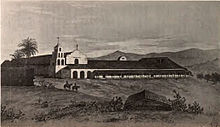
Mission San Diego de Alcalá drawn as it was in 1848. Established in 1769, it is the first of the California Missions established
The first European effort to explore the coast as far north as the Russian River was a Spanish sailing expedition, led by Portuguese captain Juan Rodríguez Cabrillo, in 1542. Some 37 years later English explorer Francis Drake also explored and claimed an undefined portion of the California coast in 1579. Spanish traders made unintended visits with the Manila Galleons on their return trips from the Philippines beginning in 1565.[42] Sebastián Vizcaíno explored and mapped the coast of California in 1602 for New Spain.
Finally, after the Portola expedition of 1769-70, Spanish missionaries began setting up 21 California Missions on or near the coast of Alta (Upper) California, beginning in San Diego. During the same period, Spanish military forces built several forts (presidios) and three small towns (pueblos). Two of the pueblos grew into the cities of Los Angeles and San Jose.
19th century
The Russian Empire established their largest settlement in California at Fort Ross in 1812
Map showing Alta California in 1838 when it was a sparsely populated Mexican province.[43]
Merchant ships fill San Francisco harbor in 1850 or 1851
Chinese gold miners in California
Cattle ranches, or ranchos, emerged as the dominant institutions of Mexican California. After Mexican independence from Spain, the chain of missions became the property of the Mexican government and were secularized by 1834.[44] The ranchos developed under ownership by Californios (Spanish-speaking Californians) who had received land grants, and traded cowhides and tallow with Boston merchants.
Beginning in the 1820s, trappers and settlers from the U.S. and Canada began to arrive in Northern California. These new arrivals used the Siskiyou Trail, California Trail, Oregon Trail and Old Spanish Trail to cross the rugged mountains and harsh deserts surrounding California. In this period, Imperial Russia explored the California coast and established a trading post at Fort Ross.
In between 1831 to 1836, California experienced a series of revolts against Mexico;[45] this culminated in the 1836 California revolt lead by Juan Bautista Alvarado, which ended after Mexico appointed him governor of the department.[46] The revolt, which had momentarily declared California an independent state, was successful with the assistance of American and British residents of California,[47] including Isaac Graham;[48] after 1840, 100 of those residents who did not have passports were arrested, leading to the Graham affair in 1840.[47]
In 1846 settlers rebelled against Mexican rule during the Bear Flag Revolt. Afterwards, rebels raised the Bear Flag (featuring a bear, a star, a red stripe and the words "California Republic") at Sonoma. The Republic's only president was William B. Ide,[49] who played a pivotal role during the Bear Flag Revolt.
The California Republic was short lived; the same year marked the outbreak of the Mexican-American War (1846–1848). When Commodore John D. Sloat of the United States Navy sailed into Monterey Bay and began the military occupation of California by the United States, Northern California capitulated in less than a month to the U.S. forces. After a series of defensive battles in Southern California, the Treaty of Cahuenga was signed by the Californios on January 13, 1847, securing American control in California.
Following the Treaty of Guadalupe Hidalgo that ended the war, the region was divided between Mexico and the U.S.; the western territory of Alta California, was to become the U.S. state of California, and Arizona, Nevada, Colorado and Utah became U.S. Territories, while the lower region of California, the Baja Peninsula, remained in the possession of Mexico.
In 1846 the non-native population of California was estimated to be no more than 8,000, plus about 100,000 Native Americans down from about 300,000 before Hispanic settlement in 1769.[50] After gold was discovered, the population burgeoned with U.S. citizens, Europeans, Chinese and other immigrants during the great California Gold Rush. By 1854 over 300,000 settlers had come.[51] Between 1847 and 1870, the population of San Francisco increased from 500 to 150,000.[52] On September 9, 1850, as part of the Compromise of 1850, California was admitted to the United States undivided as a free state, denying the expansion of slavery to the Pacific Coast.
California's native population precipitously declined, above all, from Eurasian diseases to which they had no natural immunity.[53] Like in other states, the native inhabitants were forcefully removed from their lands by incoming miners, ranchers, and farmers. And although California entered the union as a free state, the "loitering or orphaned Indians" were de facto enslaved by Mexican and Anglo-American masters under the 1853 Act for the Government and Protection of Indians.[54] There were several massacres in which hundreds of indigenous people were killed. Between 1850 and 1860, California paid around 1.5 million dollars (some 250,000 of which was reimbursed by the federal government)[55] to hire militias whose purpose was to protect settlers from the indigenous populations. In subsequent decades, the native population was placed in reservations and rancherias, which were often small and isolated and lacked adequate natural resources or funding from the government to sustain the populations living on them.[54] As a result, the rise of California brought great hardship for the native inhabitants. Several scholars and Native American activists, including Benjamin Madley and Ed Castillo, have described the actions of the California government as a genocide.[56]
The seat of government for California under Spanish and later Mexican rule was located at Monterey from 1777 until 1845.[44] Pio Pico, last Mexican governor of Alta California, moved the capital to Los Angeles in 1845. The United States consulate was also located in Monterey, under consul Thomas O. Larkin.
In 1849, the Constitutional Convention was first held in Monterey. Among the tasks was a decision on a location for the new state capital. The first legislative sessions were held in San Jose (1850–1851). Subsequent locations included Vallejo (1852–1853), and nearby Benicia (1853–1854); these locations eventually proved to be inadequate as well. The capital has been located in Sacramento since 1854[57] with only a short break in 1861 when legislative sessions were held in San Francisco due to flooding in Sacramento.
Initially, travel between California and the rest of the continental U.S. was time consuming and dangerous. A more direct connection came in 1869 with the completion of the First Transcontinental Railroad through Donner Pass in the Sierra Nevada mountains. Once completed, hundreds of thousands of U.S. citizens came west, where new Californians were discovering that land in the state, if irrigated during the dry summer months, was extremely well suited to fruit cultivation and agriculture in general. Vast expanses of wheat, other cereal crops, vegetable crops, cotton, and nut and fruit trees were grown (including oranges in Southern California), and the foundation was laid for the state's prodigious agricultural production in the Central Valley and elsewhere.
20th century
Migration to California accelerated during the early 20th century with the completion of major transcontinental highways like the Lincoln Highway and Route 66. In the period from 1900 to 1965, the population grew from fewer than one million to become the most populous state in the Union. In 1940, the Census Bureau reported California's population as 6.0% Hispanic, 2.4% Asian, and 89.5% non-Hispanic white.[58] The 1906 San Francisco earthquake and 1928 St. Francis Dam flood remain the deadliest in U.S history.[59]To meet the population's needs, major engineering feats like the California and Los Angeles Aqueducts; the Oroville and Shasta Dams; and the Bay and Golden Gate Bridges were built across the state. The state government also adopted the California Master Plan for Higher Education in 1960 to develop a highly efficient system of public education.
Meanwhile, attracted to the mild Mediterranean climate, cheap land, and the state's wide variety of geography, filmmakers established the studio system in Hollywood in the 1920s. California manufactured 8.7 percent of total United States military armaments produced during World War II, ranking third (behind New York and Michigan) among the 48 states.[60] After World War II, California's economy greatly expanded due to strong aerospace and defense industries,[61] whose size decreased following the end of the Cold War.[61][62] Stanford University and its Dean of Engineering Frederick Terman began encouraging faculty and graduates to stay in California instead of leaving the state, and develop a high-tech region in the area now known as Silicon Valley.[63] As a result of these efforts, California is regarded as a world center of the entertainment and music industries, of technology, engineering, and the aerospace industry, and as the U.S. center of agricultural production. Just before the "Dot Com Bust" California had the 5th largest economy in the world among nations.
Demographics
Main article: Demographics of California
Population
| Historical population | |||
|---|---|---|---|
| Census | Pop. | %± | |
| 1850 | 92,597 | ||
| 1860 | 379,994 | 310.4% | |
| 1870 | 560,247 | 47.4% | |
| 1880 | 864,694 | 54.3% | |
| 1890 | 1,213,398 | 40.3% | |
| 1900 | 1,485,053 | 22.4% | |
| 1910 | 2,377,549 | 60.1% | |
| 1920 | 3,426,861 | 44.1% | |
| 1930 | 5,677,251 | 65.7% | |
| 1940 | 6,907,387 | 21.7% | |
| 1950 | 10,586,223 | 53.3% | |
| 1960 | 15,717,204 | 48.5% | |
| 1970 | 19,953,134 | 27.0% | |
| 1980 | 23,667,902 | 18.6% | |
| 1990 | 29,760,021 | 25.7% | |
| 2000 | 33,871,648 | 13.8% | |
| 2010 | 37,253,956 | 10.0% | |
| Est. 2014 | 38,340,000 | 2.9% | |
| Sources: 1790–1990, 2000, 2010[4][64][65] Chart does not include Indigenous population figures. Studies indicate that the Native American population in California in 1850 was close to 150,000 before declining to 15,000 by 1900.[54][66] |
|||
California is the second-most-populous sub-national entity in the Western Hemisphere and the Americas, with a population second to that of State of São Paulo, Brazil.[70] California's population is greater than that of all but 34 countries of the world.[71][72] Also, Los Angeles County has held the title of most populous U.S. county for decades, and it alone is more populous than 42 U.S. states.[73][74] In addition, California is home to eight of the 50 most populous cities in the United States: Los Angeles (2nd), San Diego (8th), San Jose (10th), San Francisco (13th), Fresno (34th), Sacramento (35th), Long Beach (36th), and Oakland (47th). The center of population of California is located in the town of Buttonwillow, Kern County.[note 1]
Immigration
Starting in the year 2010, for the first time since the California Gold Rush, California-born residents make up the majority of the state's population.[76] In 2011, California saw a shift in its immigration pattern, with more coming from Asia and less from Latin America.[77] In total for 2011, there were 277,304 immigrants. 57% came from Asian countries vs. 22% from Latin American countries.[77]The state's population of illegal immigrants has been shrinking in recent years, due to increased enforcement and a slumping economy.[78] The number of migrants arrested attempting to cross the Mexican border in the Southwest plunged from a high of 1.1 million in 2005 to just 367,000 in 2011.[79] Illegal alien constituted an estimated 7.3 percent of the state's population, the third highest percentage of any state in the country,[80][note 2] totaling nearly 2.6 million.[81] More than half originate from Mexico.[81] Illegal aliens make up more than ten percent of the population in Los Angeles, Monterey, San Benito, Imperial, and Napa Counties – the latter four of which have significant agricultural industries that depend on manual labor.[82]
Racial and ancestral makeup
According to the U.S. Census Bureau in 2011:[83]- 74.0% White (39.7% Non-Hispanic White, 34.3% Hispanic White)
- 13.6% Asian (3.4% Filipino, 3.2% Chinese, 1.6% Vietnamese, 1.4% Indian, 1.2% Korean, 0.7% Japanese, 0.2% Hmong, 0.2% Cambodian, 0.2% Laotian, 0.1% Thai, 0.1% Pakistani)
- 6.6% Black or African American
- 1.7% Native American
- 3.6% Multiracial (1.3% White and "Some Other Race", 1.2% White and Asian, 0.6% White and Native American, 0.5% White and Black, 1.3% Other)
- 0.5% Native Hawaiian or Pacific Islander (0.1% Samoan, 0.1% Guamanian or Chamorro, 0.1% Native Hawaiian, 0.2% "Other Pacific Islander")
- 38.1% are Hispanic or Latino (of any race) (31% Mexican, 1.5% Salvadoran, 0.9% Guatemalan, 0.5% Puerto Rican, 0.3% Nicaraguan, 0.2% Honduran, 0.2% Cuban, 0.2% Colombian, 0.2% Peruvian)
- 61.9% of the population is Non-Hispanic (of any race)
| Racial composition | 1970[84] | 1990[84] | 2000[85] | 2010[86] |
|---|---|---|---|---|
| White | 89.0% | 69.0% | 59.5% | 57.6% |
| Asian | 2.8% | 9.6% | 10.9% | 13.1% |
| Black | 7.0% | 7.4% | 6.7% | 6.2% |
| Native | 0.5% | 0.8% | 1.0% | 1.0% |
| Native Hawaiian and other Pacific Islander |
– | – | 0.3% | 0.4% |
| Other race | 0.7% | 13.2% | 16.8% | 17.0% |
| Two or more races | – | – | 4.8% | 4.9% |
With regard to demographics, California has the largest population of White Americans in the U.S., an estimated 22,200,000 residents, although most demographic surveys do not measure actu




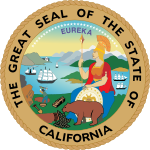
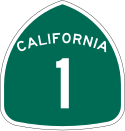

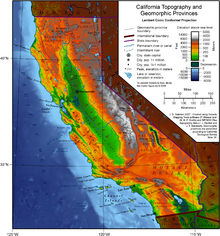
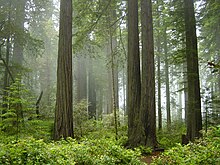


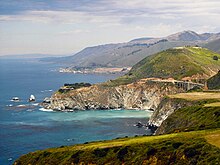








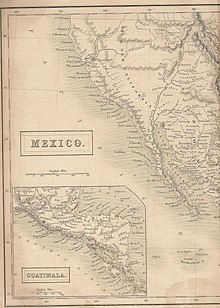
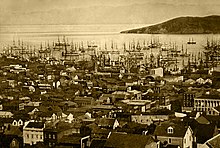

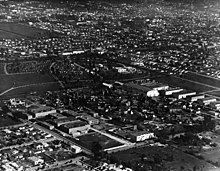
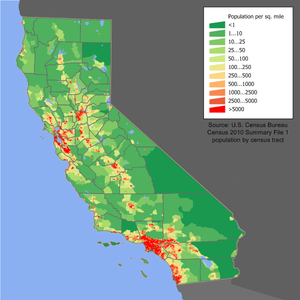

Keine Kommentare:
Kommentar veröffentlichen